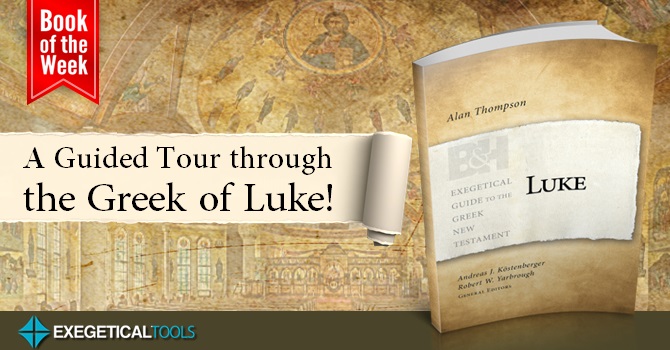
When the Exegetical Guides to the Greek New Testament first appeared, Murray Harris published a lone volume on Colossians and Philemon with Eerdmans in the early ’90s. When the series was abandoned, B&H Academic picked it up, republished Harris’ volume, and contracted the rest out. Since then, volumes on Philippians, John, 1 Peter, and James have all appeared. The latest volume to appear tackles the toughest Greek yet of any of the volumes: Luke’s Gospel.
Alan Thompson is a brave man to explain every phrase in Luke, piece by piece, twenty four chapters long. But he accepted the challenge and executed it laudably. I actually had the opportunity to proof-read this volume so I worked through it in painstaking detail. I can tell you that Thompson’s research must have taken years and he packs it into a neat 400 pages. If you are preaching, teaching, or studying Luke, you will want this volume at your side.
As with all the EGGNT volumes, there is a brief introduction with recommended commentaries, which Thompson uses throughout. Each section ends with homiletical suggestions and some sections also conclude with suggestions for further reading (e.g., in the midst of the songs in chs. 1-2, after 2:21 Thompson includes nine sources for further study of Christology in Luke’s Gospel). The end of the book contains a large exegetical outline for the entire Gospel, a guide to common verb forms not parsed in the guide, and a grammar and Scripture index. The grammar index is useful for those who want to look up examples of grammatical features in specific texts for practice.
The explanation of the language throughout the guide is, naturally, more concise than the volumes on the epistles for two reasons. First, Luke is narrative rather than epistolary, so in many cases much less hinges on the precise meaning of a conjunction or preposition. Second, Luke is 24 chapters while the epistles published on so far are 4-5 chapters, so Thompson has to pick his battles. The result is that this EGGNT volume looks more similar to the other Baylor Greek Handbook volumes, which tend to simply state the author’s opinion on a grammatical decision rather than laying out all the possible options.
Ironically, the Luke volume in the Baylor series by Culy is a bit longer than Thompson’s (800 pages, but with smaller pages). Some have already asked what the difference is between the two. I’ve used sections of Culy’s, and I’ve used lots of the EGGNT and Baylor volumes. The biggest difference between the volumes is that EGGNT restricts itself intentionally to the sentence level, while the Baylor volume tries to integrate more recent linguistic methods such as discourse analysis and verbal aspect theory. So while Baylor volumes tend to be better for understanding the discourse as a whole, EGGNT volumes are best for focusing on the trees (while getting a grasp on the forest might be too difficult).
Overall this volume is executed successfully, with heavy citations of grammars and commentaries throughout. Note, however, that this volume is not a full commentary. This volume is intended to help you translate the text by understanding how the Greek words are functioning in the sentence. There are parsing helps for most verbs and definitions of rarer words. But do not look to this volume for theological commentary or full-blown exegesis. That is not its purpose!
Use this volume for what it is: a trustworthy guide to understanding the sentences in the Greek text of Luke. And for that purpose, I cannot commend it highly enough.
Preview or buy it on Amazon.

